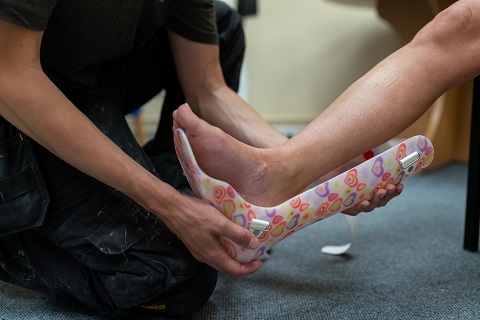Using & Caring for Orthotics
Orthotics are prescription devices that fit inside your shoes to provide support and stabilization in key areas. Orthotics can change the amount of force your foot feels with each step or alter the location of the pressure. Prescription orthotics incorporate neurofeedback that can train your brain to make corrective movements as you walk, improving a number of foot conditions and providing both comfort and pain relief. It’s important to care for your orthotics properly so they can continue to care for your feet.
How To Use Your Orthotics

Your doctor will give you detailed instructions on how to use your orthotics. In most cases, you’ll remove the original insoles from your footwear and replace them with your custom orthotics. Orthotics are often molded to fit a particular pair or type of shoes. If this is the case, it’s important to use your orthotics only in those shoes. For example, the orthotics that you wear in your tennis shoes won’t fit properly in a pair of heels. Talk to your doctor about getting custom orthotics for the shoes you wear most.
It’s very important to break in the orthotics over the course of 2-3 weeks, increasing the time you wear the devices an hour a day. It is important not to do any strenuous activities until you can wear the orthotics for a full 8 hours. New orthotics may feel strange, but they shouldn’t cause uncomfortable pressure or pain. If you experience serious discomfort with your orthotics, talk to your doctor as soon as possible to remedy the issue.
How To Clean Your Orthotics
Most orthotics are made of plastic and top covers, which may be leather or manmade materials. They can be easily spot-cleaned and if they get fully wet, just let them fully dry and they will be back to new. Typically the top and bottom cover materials can be glued back if they lift a bit. Never place them in a washing machine or dishwasher, as this will expose them to hazards such as high temperatures, extreme water pressure, and continued agitation. At best, this will shorten the life of your orthotics, and at worst, it may destroy them immediately.
How To Dry Your Orthotics
After gently wiping down your orthotics with soap and water, you can go over them with a clean, dry towel. Then, set them out in a clean, safe place to air dry completely. Don’t use a clothes dryer or blow dryer to dry the orthotics, as this can cause them to shrink, warp, or otherwise become damaged.
You should avoid puddles and wet ground while you’re wearing orthotics. However, it’s not always possible to keep your shoes completely dry. If your orthotics get wet, take them out as soon as you can and set them on a flat surface to air dry. You should always allow the orthotics to dry completely before wearing them again.
How To Remove Odors From Orthotics
Orthotics can begin to take on foot odors over time. You can eliminate odors by sprinkling baking soda or baby powder on the orthotics. If you want to keep these powders contained, place the orthotics in a plastic bag with the powder. Leave your orthotics in the powder for about an hour, then remove them. A light spritz of Febreze can eliminate odors on your orthotics as well. Make sure you don’t saturate them, and allow them to dry completely before you wear them again.
When To Remove Orthotics
Remove your orthotics at the end of every day so they can dry in the fresh air. Don’t leave them within the confines of your shoe for too long. Clean out your shoes at least once a week, shaking them to get rid of any dirt, gravel, or debris. You may need to use a brush to get small contaminants such as sand out of your shoes. Inspect your orthotic covers each time you take them out to look for signs of wear. One trick if an orthotic is smelly, is to crumple up newspaper and place it inside the shoe as that will help remove odors. Odors can also happen when the orthotics get wet -just let them air dry. Refurbishing orthotics can be done easily from our office. This should be done about every 4-6 years or earlier if they are tearing or peeling apart.
How To Protect Your Orthotics
Store your orthotics in a safe, dry place. Keep them away from pets at all times. If you have animals that diligently seek out shoes to play with or chew on, consider keeping your orthotics on top of a shelf or in a drawer where pets can’t reach them. Always use your orthotics in the shoes for which they were designed.
Keep your orthotics away from heat and sunlight. Don’t leave them in your car, gym bag, or garage. Make sure you don’t kick your shoes off in the sun while your orthotics are in them so you can properly protect these prescription inserts.
When To Replace Orthotics
Custom shoe prescription orthotics will last much longer than over-the-counter inserts. However, even high-quality orthotics will eventually reach the end of their life span. Most orthotics will last for quite a few years when they are taken care of. Typically, orthotics refurbishing is done every 5 years or so depending on the material, design, and frequency of use. As your orthotics near the end of their functional life, they may develop cracks. At our lab the devices are covered under a warranty, and if they crack they will replace the shell and make a new device. You might see visible wear in certain areas, such as thinning of the insert. If your orthotics have extra pieces, such as straps, these may wear out or break first, indicating that your orthotics need to be replaced.
Book Your Orthotics Appointment Today
If you’re suffering from foot pain or discomfort, custom orthotics may help. A podiatrist can thoroughly examine your feet, evaluate your shoes, and assess your gait to determine whether orthotics are the right solution. Make an appointment with Dr. Schoene, Dr. Bever, and Dr. Joseph at Gurnee Podiatry & Sports Medicine Assoc. in the Gurnee area and at our Chicago, IL offices to learn whether custom orthotics can improve your foot comfort and health.
